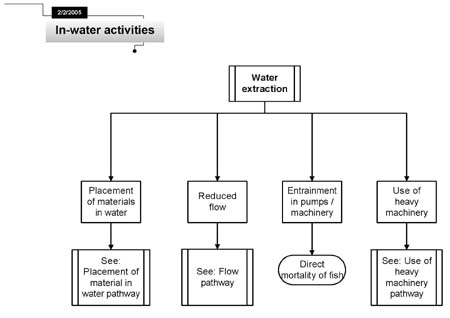Water extraction
In-Water Activities
- Addition or removal of aquatic vegetation
- Change in timing, duration and frequency of flow
- Dredging
- Fish passage issues
- Marine seismic surveys
- Organic debris management
- Placement of material or structures in water
- Structure removal
- Use of explosives
- Use of industrial equipment
- Wastewater management
- Water extraction
Water-taking from groundwater sources, lakes, and rivers for a variety of purposes such as municipal drinking water supplies, irrigation of agricultural lands and golf courses, and industrial functions such as nuclear facilities, pulp mills, mining, and hydroelectric power generation. A distinction may be drawn between "consumptive" (water not returned to the watershed, as in water bottling and beverage manufacturing) and "non-consumptive" (such as municipal drinking water supplies) water-taking activities. This is achieved primarily through pumping.
NOTE:
Pathways of Effects diagrams have been developed by Fisheries and Oceans Canada as a tool to communicate potential effects of development proposals on fish and fish habitat and were developed through extensive consultation. It is expected that these diagrams will be updated to describe new activities and stressors as required.

Effects
Direct or indirect mortality of fish: Unpolluted and adequate stream flow is required by fish to maintain habitat accessibility, water temperature, and dissolved oxygen levels. Irresponsible water extraction can result in the dewatering of downstream areas, obstruction of fish passage, and entrainment or impingement of fish on pump screens.
- Date modified: